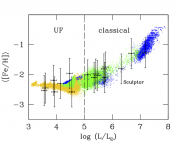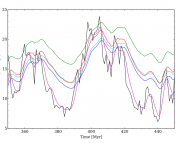Authors: Tobias Buck, Aura Obreja, Bridget Ratcliffe, Yuxi(Lucy) Lu, Ivan Minchev, Andrea V. Macciò
First Author’s Institution: Universität Heidelberg, Interdisziplinäres Zentrum für Wissenschaftliches Rechnen, Im Neuenheimer Feld 205, D-69120 Heidelberg, Germany
Status: Published in Monthly Notices of the Royal Astronomical Society [open access]
Galaxy merger events (where two or more galaxies collide and combine) have shaped the way that galaxies form and evolve throughout the history of the Universe. In today’s paper, astronomers show how such collisions have likely stirred up the distribution of metals within our own galaxy over time.
The Milky Way is one giant LEGO construction, over 13 billion years in the making
A key theory behind our understanding of how all structure in the Universe forms and evolves is called Hierarchical Structure Formation Theory (also known as bottom-up theory). In essence, it states that the smallest structures in the very early Universe collided and merged (i.e., like LEGO blocks) to form more and more massive structures over time, eventually forming the largest galaxies that we observe. Over the years, multiple studies have shown (from so-called ‘Galactic Archaeology’ tools) that our own galaxy, the Milky Way, is the product of many such merger events.
The last major merger event, which resulted in the birth of the Milky Way as we know it today, is known as the Gaia-Sausage-Enceladus merger (simultaneously named after the telescope that made the discovery, the sausage-shaped orbit of the remnant stars from the now-swallowed galaxy, and the Titan son of Gaia in Greek Mythology…), or GSE for short. A beautiful example of a similar merger event currently taking place in the nearby galaxy, M51, is shown in Figure 1. The Galactic Archaeology toolbox reveals that the GSE merger happened around ten billion years ago. Interestingly, recent studies have found that a key property of the Milky Way, its metallicity gradient, was significantly steeper at around the same time as this GSE event.
What do we mean by a ‘metallicity gradient’?
If you’ve seen any of my previous astrobites, you’ll know that metallicity is really important when studying the evolution of a galaxy. By metallicity, astronomers mean the amount heavy elements relative to the amount of hydrogen; the lightest and most abundant element in the Universe. When looking at a large sample of galaxies, we can investigate the mass-metallicity and star formation relations, which tell us how stars form from and enrich their surrounding gas. We can also look at the distribution of metals within an individual galaxy and learn more about its formation and merger history.
In the Milky Way (and many other galaxies), we see that the metallicity decreases as you move further away from the centre of our galaxy, i.e., there is a negative metallicity gradient. This essentially means that the galaxy has formed ‘inside-out’, with the central regions being more enriched with metals simply because the stars there have had longer to enrich their surroundings compared to the younger, outer regions of the galaxy. With a new method described in Lu et al. (2022), we can now effectively wind back the clock of our galaxy and see how this metallicity gradient has changed over the past ~13 billion years. From this study, and other studies using different methods, it seems that 11 to 8 billion years ago (so at the time of the GSE event), this metallicity gradient was steeper. This has important effects on how we view the evolution of the Milky Way.
A change in the metallicity gradient at the same time as the last major merger… is this just a coincidence?
This question forms part of the focus of today’s paper. The way this question can be addressed is as follows: suppose we create a bunch of galaxies and simulate their evolution over time, including a variety of merger events according to that all-important hierarchical, or LEGO, structure formation theory. With these simulations, we can then see exactly what the galaxy looked like before, during and after the merger events, and find out if we do indeed see a steepening of the metallicity gradient caused by these mergers. To do this, the authors selected 4 galaxies that were the most similar to the Milky Way from their sample of simulated galaxies (the NIHAO-UHD simulations, to be specific). Each of these galaxies are simulated from 0 to 13 billion years, and each experienced several major merger events, much like GSE.
In Figure 2, we show snapshots from the simulation of the total gas, metal-rich gas and metal-poor gas (from left to right) for one of these simulated galaxies before, during and after a major merger event (top to bottom). In Figure 3, we then show how the size (orange line) and the metallicity gradient (blue line) of the four simulated galaxies evolves over time, where the grey shaded area shows the time when the most significant major mergers happened, causing a spike in both the size and metallicity gradient of the galaxies.
The findings are clear: massive mergers can indeed cause the metallicity gradient of a galaxy to steepen (increase), and they seem to do this by suddenly increasing the size of the galaxy and diluting (i.e. decreasing the metallicity) in its outskirts. It’s therefore likely that the GSE event is the main culprit behind the unexpected steepening of the metallicity gradient that we see in our own galaxy. Such a finding can help shed light on our understanding of how the modern Milky Way, and therefore ourselves, formed and evolved from the tiniest LEGO blocks to the complex, diverse structures we see today.
Astrobite edited by Sonja Panjkov
Featured image credit: NASA, ESA, S. Beckwith (STScI) and the Hubble Heritage Team (STScI/AURA)




